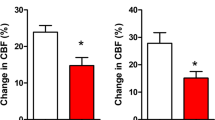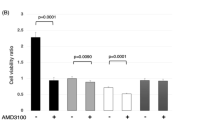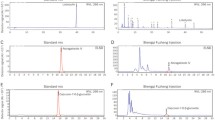Abstract
Radiation-induced brain injury (RBI) is the most serious complication after radiotherapy. However, the etiology of RBI remains elusive. In order to evaluate the effect of X-rays on normal brain tissue, adult male BALB/C mice were subjected to whole-brain exposure with a single dose of 10 Gy or sham radiation. The structure and number of mice brain vessels were investigated 1, 7, 30, 90 and 180 days after irradiation by H&E staining and immune-fluorescence staining. Compared with sham control mice, in addition to morphological changes, a significant reduction of microvascular density was detected in irradiated mice brains. Whole-brain irradiation also caused damage in tight junction (TJ). Increased expression of glial fibrillary acidic protein (GFAP) and vascular endothelial growth factor (VEGF) was observed in irradiated mouse brains showed by Western Blot. Immune-fluorescence staining results also verified the co-labeling of GFAP and VEGF after whole-brain irradiation. Furthermore, the protein expression levels of other angiogenesis factors, angiopoietin-1 (Ang-1), endothelial-specific receptor tyrosine kinase (Tie-2), and angiopoietin-2 (Ang-2) in brain were determined by Western Blot. Increased expression of Ang-2 was shown in irradiated mouse brains. In contrast, whole-brain irradiation significantly decreased Ang-1 and Tie-2 expression. Our data indicated that X-rays induced time-dependent microvascular injury and activation of astrocytes after whole-brain irradiation in mouse brain. Distinct regulation of VEGF/Ang2 and Ang-1/Tie-2 are closely associated with RBI, suggesting that angiogenesis interventions might be beneficial for patients with RBI.





Similar content being viewed by others
References
Zhang Y et al (2016) Neuroprotective effects of Kukoamine a against radiation-induced rat brain injury through inhibition of oxidative stress and neuronal apoptosis. Neurochem Res 41(10):2549–2558
Regal PJ et al (2014) Acute late-onset encephalopathy after radiotherapy: an unusual life-threatening complication. Neurology 82(12):1102
Gupta M et al (2013) Comparative evaluation of brain neurometabolites and DTI indices following whole body and cranial irradiation: a magnetic resonance imaging and spectroscopy study. NMR Biomed 26(12):1733–1741
Coderre JA et al (2006) Late effects of radiation on the central nervous system: role of vascular endothelial damage and glial stem cell survival. Radiat Res 166(3):495–503
Liu Y et al (2010) An experimental study of acute radiation-induced cognitive dysfunction in a young rat model. AJNR Am J Neuroradiol 31:383–387
Nonoguchi N et al (2011) The distribution of vascular endothelial growth factor-producing cells in clinical radiation necrosis of the brain: pathological consideration of their potential roles. J Neurooncol 105:423–431
Wei M et al (2012) Increased expression of EMMPRIN and VEGF in the rat brain after gamma irradiation. J Korean Med Sci 27(3):291–299
Lee SW et al (2009) Angiopoietin-1 reduces vascular endothelial growth factor-induced brain endothelial permeability via upregulation of ZO-2. Int J Mol Med 23(2):279–284
Ridet JL et al (1997) Reactive astrocytes: cellular and molecular cues to biological function. Trends Neurosci 20:570–577
Augustin HG et al (2009) Control of vascular morphogenesis and homeostasis through the angiopoietin-Tie system. Nat Rev Mol Cell Biol 10(3):165–177
Zhu Y, Lee C et al (2005) Angiopoietin-2 facilitates vascular endothelial growth factor-induced angiogenesis in the mature mouse brain. Stroke 36(7):1533–1537
Zhou H et al (2011) Fractionated radiation-induced acute encephalopathy in a young rat model: cognitive dysfunction and histologic findings. Am J Neuroradiol 32(10):1795–1800
Nordal RA et al (2004) Hypoxia and hypoxia-inducible factor-1 target genes in central nervous system radiation injury: a role for vascular endothelial growth factor. Clin Cancer Res 10(10):3342–3353
Brown WR et al (2007) Capillary loss precedes the cognitive impairment induced by fractionated whole-brain irradiation: a potential rat model of vascular dementia. J Neurol Sci 257:67–71
Tanino T et al (2013) Radiation-induced microbleeds after cranial irradiation: evaluation by phase-sensitive magnetic resonance imaging with 3.0 T. Yonago Acta Med 56(1):7–12
Drigotas M et al (2013) Reactive oxygen species activation of MAPK pathway results in VEGF upregulation as an undesired irradiation response. J Oral Pathol Med 42(8):612–619
Ferrara N (1999) Vascular endothelial growth factor: molecular and biological aspects. Curr Top Microbiol Immunol 237:1–30
Breier G et al (1992) Expression of vascular endothelial growth factor during embryonic angiogenesis and endothelial cell differentiation. Development 114:521–532
Plate KH (1999) Mechanisms of angiogenesis in the brain. J Neuropathol Exp Neurol 58:313–320
Yancopoulos GD et al (2000) Vascular-specific growth factors and blood vessel formation. Nature 407(6801):242–248
Owen MR et al (2009) Angiogenesis and vascular remodelling in normal and cancerous tissues. J Math Biol 58(4–5):689–721
Lau LT et al (2001) Astrocytes produce and release interleukin-1, interleukin-6, tumor necrosis factor alpha and interferon-gamma following traumatic and metabolic injury. J Neurotrauma 18:351–359
Etoh T et al (2001) Angiopoietin-2 is related to tumor angiogenesis in gastric carcinoma: possible in vivo regulation via induction of proteases. Cancer Res 61(5):2145–2153
Kutryk MJ et al (2003) Angiogenesis of the heart. Microsc Res Tech 60(2):138–158
Davis S et al (1996) Isolation of angiopoietin-1, a ligand for the TIE2 receptor, by secretion-trap expression cloning. Cell 87:1161–1169
Cascone I et al (2003) Tie-2-dependent activation of RhoA and Rac1 participates in endothelial cell motility triggered by angiopoietin-1. Blood 102(7):2482–2490
Zhang L et al (2003) Tumor-derived vascular endothelial growth factor up- regulates angiopoietin-2 in host endothelium and destabilizes host vasculature, supporting angiogenesis in ovarian cancer. Cancer Res 63(12):3403–3412
Maisonpierre PC et al (1997) Angiopoietin-2, a natural antagonist for Tie2 that disrupts in vivo angiogenesis. Science 277(5322):55–60
Chae SS et al (2010) Angiopoietin-2 interferes with anti-VEGFR2-induced vessel normalization and survival benefit in mice bearing gliomas. Clin Cancer Res 16(14):3618–3627
Jain RK (2005) Normalization of tumor vasculature: an emerging concept in antiangiogenic therapy. Science 307(5706):58–62
Goel S et al (2011) Normailization of the vasculature for treatment of cancer and other diseases. Physiol Rev 91(3):1071–1121
Lee WH et al (2011) Radiation attenuates physiological angiogenesis by differential expression of VEGF, ang-1, tie-2 and ang-2 in rat brain. Radiat Res 176(6):753–760
Funding
The funding was provided by Guangzhou Science and Technology Program (CN) (Grant No. 2014Y2-00155) and National Natural Science Foundation of China (Grant No. 81271386).
Author information
Authors and Affiliations
Corresponding author
Ethics declarations
Conflict of interest
None.
Electronic Supplementary Material
Below is the link to the electronic supplementary material.
Rights and permissions
About this article
Cite this article
Deng, Z., Huang, H., Wu, X. et al. Distinct Expression of Various Angiogenesis Factors in Mice Brain After Whole-Brain Irradiation by X-ray. Neurochem Res 42, 625–633 (2017). https://doi.org/10.1007/s11064-016-2118-3
Received:
Revised:
Accepted:
Published:
Issue Date:
DOI: https://doi.org/10.1007/s11064-016-2118-3




